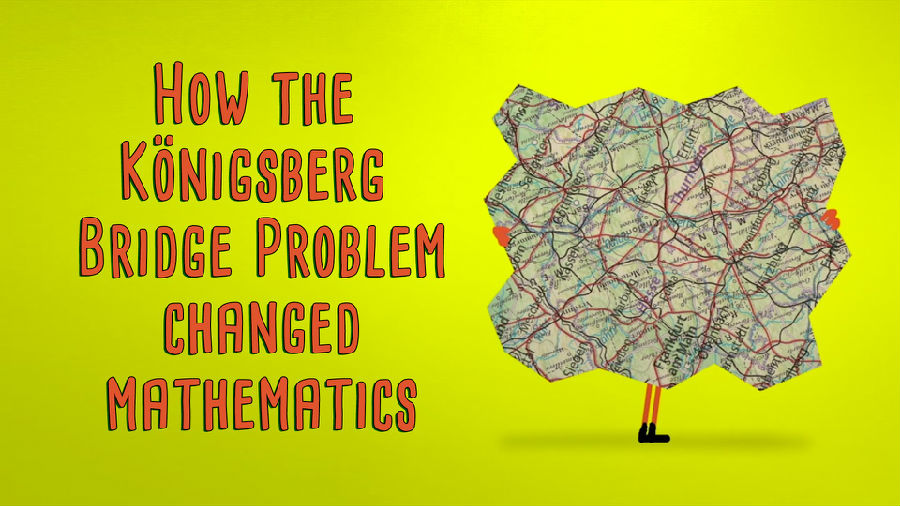(单词翻译:单击)
You'd have a hard time finding Konigsberg on any modern maps,
在现在的地图上,你很难找到哥尼斯堡这个城市,
but one particular quirk in its geography has made it one of the most famous cities in mathematics.
但是它在地理上奇特之处使得它在数学上成为最为著名的城市之一。
The medieval German city lay on both sides of the Pregel River.
这个中世纪的德国城市坐落于普雷格尔河的两岸。
At the center were two large islands.
河的中央有两座大的岛屿。
The two islands were connected to each other and to the river banks by seven bridges.
这两座岛屿通过七座桥与河的两岸及彼此连接。
Carl Gottlieb Ehler, a mathematician who later became the mayor of a nearby town, grew obsessed with these islands and bridges.
后来成为附近小镇市长的数学家卡尔·戈特利布·埃勒,对这些桥和岛屿十分着迷。
He kept coming back to a single question:
他一直在考虑一个问题:
Which route would allow someone to cross all seven bridges without crossing any of them more than once?
哪一条路径可以使人穿过所有这七座桥,并且同一座桥只能经过一次?
Think about it for a moment.
思考一下。
Give up? You should. It's not possible.
放弃了吗?应该是的。这是不可能的。
But attempting to explain why led famous mathematician Leonhard Euler to invent a new field of mathematics.
但是,大数学家莱昂哈德·欧拉在试图解释这个数学问题时,开拓了一个新的数学领域。
Carl wrote to Euler for help with the problem.
卡尔当时是向欧拉写信求助的。
Euler first dismissed the question as having nothing to do with math.
开始,欧拉认为这个问题和数学无关,所以不关心这个问题。
But the more he wrestled with it, the more it seemed there might be something there after all.
但是随着他对该问题的思考,他越来越发现该问题有一定的意义。
The answer he came up with had to do with a type of geometry that did not quite exist yet,
他得出的答案与一类几何学相关,但当时并不存在,
what he called the Geometry of Position, now known as Graph Theory.
他称之为位置几何学,就是现在著名的图论。
Euler's first insight was that the route taken between entering an island or a riverbank and leaving it didn't actually matter.
欧拉最初的想法是,进入岛屿或河岸和离开岛屿或河岸的路线实际上并不重要。
Thus, the map could be simplified with each of the four landmasses represented as a single point,
这样,地图上便可以简化为四个岛,用四个简单的点表示,
what we now call a node, with lines, or edges, between them to represent the bridges.
我们现在称之为节点,它们之间的线或边代表桥。
And this simplified graph allows us to easily count the degrees of each node.
这样,简化的图使我们比较容易计算每个节点的度。

That's the number of bridges each land mass touches.
即连接岛之间桥的数量。
Why do the degrees matter?
为什么度很重要呢?
Well, according to the rules of the challenge, once travelers arrive onto a landmass by one bridge,
试想,根据这个问题的规定,一旦有人想要通过一座桥到达一个岛屿,
they would have to leave it via a different bridge.
他就必须通过另外的桥离开。
In other words, the bridges leading to and from each node on any route must occur in distinct pairs,
也就是说,在任何路线上,通往和离开每个节点的桥必须是不同的桥,
meaning that the number of bridges touching each landmass visited must be even.
这意味着连接每个岛的桥的数量一定是偶数。
The only possible exceptions would be the locations of the beginning and end of the walk.
唯一可能的例外是在出发的位置和离开的位置。
Looking at the graph, it becomes apparent that all four nodes have an odd degree.
看下图,很明显所有四个节点的度都为奇数。
So no matter which path is chosen, at some point, a bridge will have to be crossed twice.
于是,无论选择什么样的路线,在一些点上,一座桥势必会被经过两次。
Euler used this proof to formulate a general theory that applies to all graphs with two or more nodes.
欧拉用这个证明发展出了一个通用的理论,适用于存在两个或两个以上节点的图。
A Eulerian path that visits each edge only once is only possible in one of two scenarios.
每一个边仅经过一次的欧拉路径只在两种情况下有可能。
The first is when there are exactly two nodes of odd degree, meaning all the rest are even.
第一,当仅有两个节点为奇数度时,这意味着其它的都是偶数度。
There, the starting point is one of the odd nodes, and the end point is the other.
这样,开始点就是奇数度的一个,结束点是另外一个。
The second is when all the nodes are of even degree.
第二,当所有的节点都是偶数度时。
Then, the Eulerian path will start and stop in the same location, which also makes it something called a Eulerian circuit.
那么,欧拉路径就从同一个位置开始和结束,这被称为欧拉回路。
So how might you create a Eulerian path in Konigsberg?
于是,你怎么才能在格尼斯堡找到欧拉路径呢?
It's simple. Just remove any one bridge.
这很简单。只要移走任一座桥。
And it turns out, history created a Eulerian path of its own.
结果就是,历史创造了欧拉路径。
During World War II, the Soviet Air Force destroyed two of the city's bridges, making a Eulerian path easily possible.
二战期间,苏联空军摧毁了两个城市之间的一座桥,这便创造出了欧拉路径。
Though, to be fair, that probably wasn't their intention.
虽然,公平来说,他们的目的不是这样。
These bombings pretty much wiped Konigsberg off the map, and it was later rebuilt as the Russian city of Kaliningrad.
这些炸弹从地图上抹掉了格尼斯堡,并且这里被重建为之后的俄罗斯加里宁格勒市。
So while Konigsberg and her seven bridges may not be around anymore,
所以尽管格尼斯堡和她的七座桥不再存在,
they will be remembered throughout history by the seemingly trivial riddle which led to the emergence of a whole new field of mathematics.
但是它们会因这个导致全新数学领域出现的谜团而被历史记录下来。


